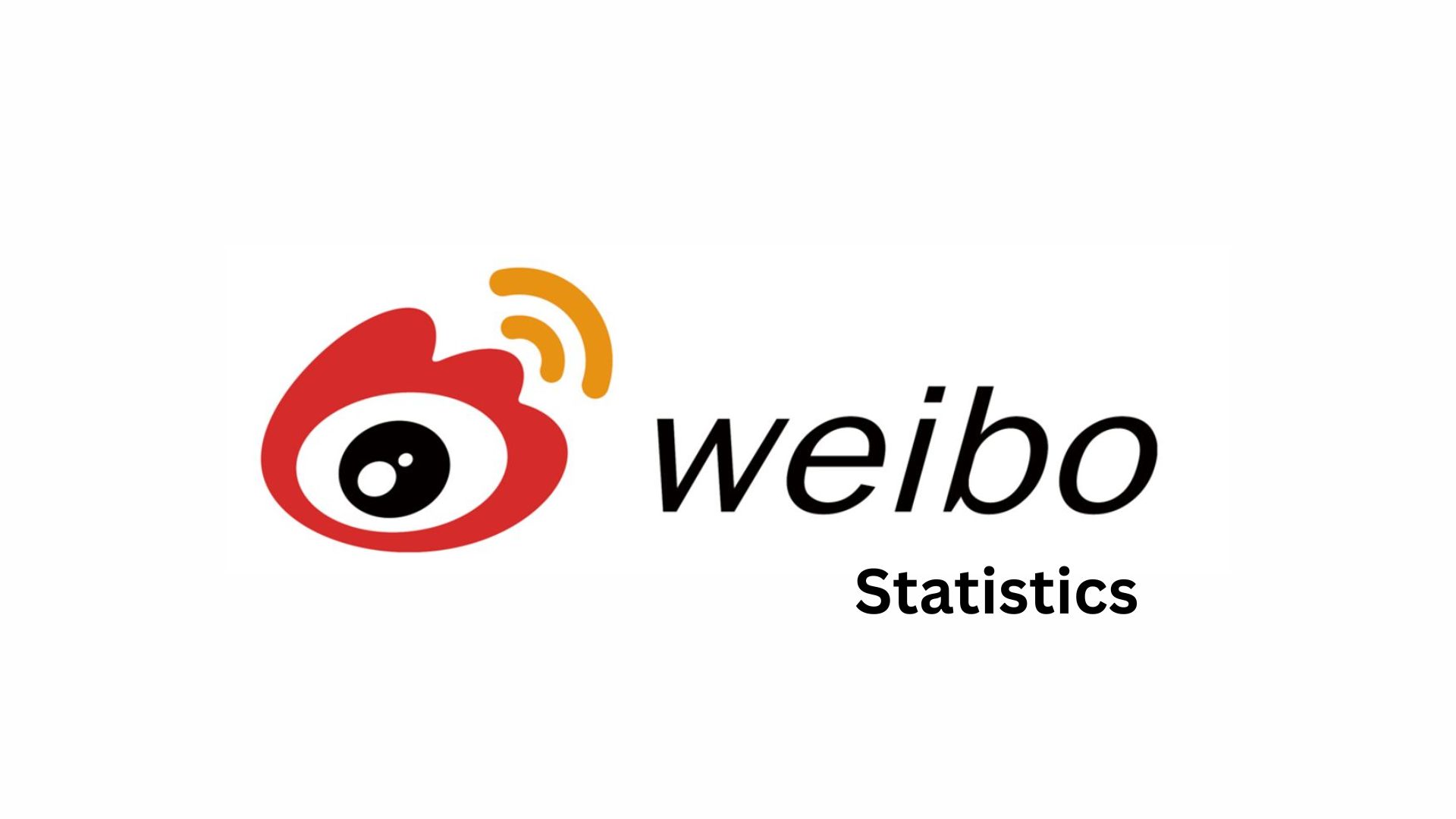Ahrefs vs SEMrush Statistics – Which is Better for SEO? (2025)
Updated · Jun 23, 2025
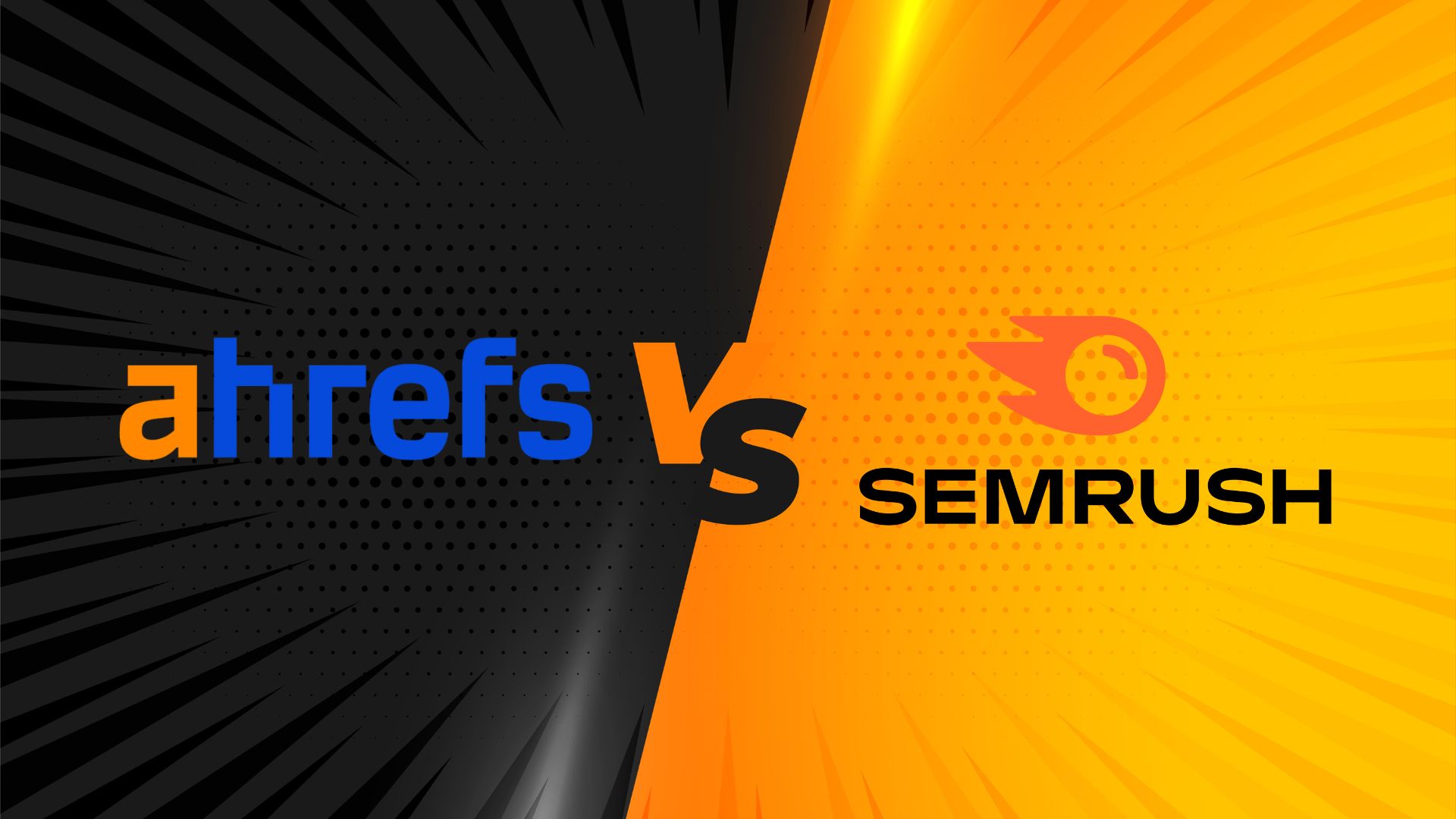
Table of Contents
Introduction
Ahrefs vs SEMrush Statistics: In the fierce SEO and digital marketing realm, Ahrefs and SEMrush stand as industry giants. While both offer full toolsets- backlink analysis, keyword research, site auditing, and rank tracking- they differ highly in the scale of operations, pricing and feature depth.
This article offers a brief performance-and usage comparison of Ahrefs vs SEMrush statistics in 2024 by looking at revenue, pricing, and user demographics. Marketers will find it insightful in deciding which platform best suits their strategy and budget.
Editor’s Choice
- Ahrefs had spurts of growth year-on-year from a modest US$1 million revenue in 2011 up to US$149.1 million in 2024, and SEMrush continued its steady quarterly pace to reach US$105 million in Q1 2025, after breaching the US$100 million mark in Q4 2024.
- Examining revenue through returns over one year better reveals jumps in revenue for Ahrefs and indicates big growth spurts; meanwhile, a steady, waxing revenue model, quarter after quarter, suggests and underpins good enterprise adoption for SEMrush.
- Starting at US$139.95 per month, the Pro Plan of SEMrush is entry-level, whereas its Lite Plan at US$129 per month is a little cheaper; both mid-level plans align with plans of about US$249 per month.
- Compared to SEMrush’s somewhat lower top-tier plan at US$499.95, Ahrefs’ indulges a much higher enterprise plan at US$1,499 per month.
- In May 2025, every week, Ahrefs was consistently showing higher and more stable total website visits than SEMrush, indicating sustained engagement and less volatility of traffic patterns.
Ahrefs vs SEMrush Revenue
Ahrefs Revenue
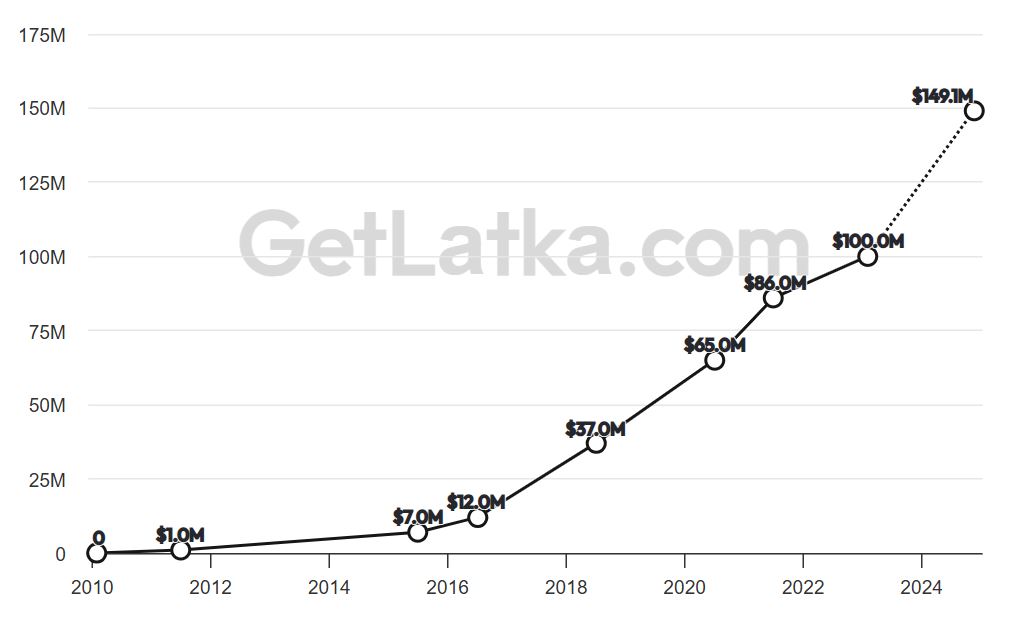
(Source: getlatka.com)
SEMrush Quarterly Revenue
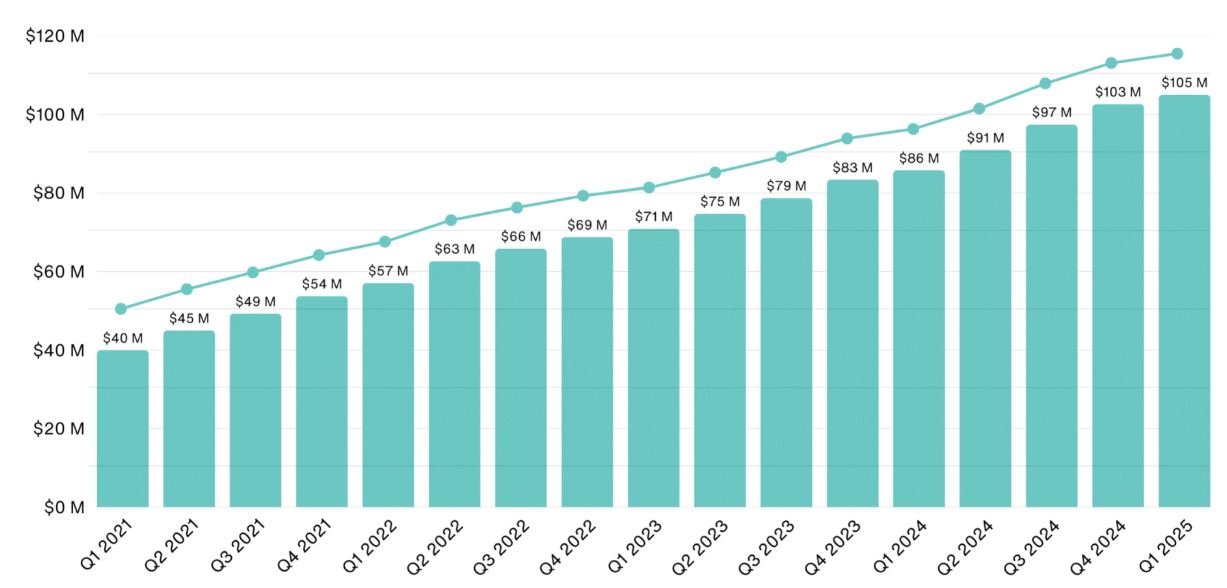
(Source: demandsage.com)
- According to Getlatka vs Demandsage, Ahrefs vs SEMrush statistics show that the revenue growth of Ahrefs and SEMrush has been impressive over the years, yet their paths and growth patterns reveal a few distinctions.
- Just after it was founded in 2010, Ahrefs grew steadily from year to year, starting with approximately US$1 million in revenues in 2011.
- By 2015, estimates ranged from about US$7 million to US$15 million, depending on the source. In 2016, Ahrefs earned revenues amounting to US$12 million, which shot up to US$37 million in 2018.
- Growth picked up pace with US$65 million in 2020 and US$86 million in 2021 to culminate in US$100 million in 2023 and a jump to US$149.1 million in 2024.
- Such a steady incline shows the growing adoption of Ahrefs globally as a referenced core SEO platform, especially among content marketers and analytics professionals.
- Conversely, SEMrush demonstrates a more granular revenue movement and gives detailed quarterly numbers confirming its steady growth.
- Starting in Q1 2021 at US$40 million, SEMrush revenues steadily increased quarter over quarter, reaching US$53.7 million in Q4 2021. This trend continued unabated through 2022, when revenues rose from US$57.1 million in Q1 to US$68.8 million in Q4.
- This momentum continued into 2023, with quarterly revenues rising from US$70.9 million to US$83.4 million by the year’s end.
- In 2024, achieving the US$100 million milestone, they grew from US$85.8 million in Q1 to US$102.6 million in Q4. By Q1 2025, revenues will have hit US$105 million.
- Compared with the annual snapshots for Ahrefs, SEMrush’s quarter-by-quarter reportage highlights the steady uptake of enterprises and increasing compound demand for digital marketing intelligence tools.
- While Ahrefs encountered more dramatic annual leaps, those gradually incremental revenue figures for SEMrush, tracked quarter after quarter, are indicative of continuous, well-established means of increasing revenue.
Ahrefs vs SEMrush Pricing
- SEMrush had recently increased the price of the entry-level Pro Plan to US$139.95 monthly, amounting to approximately US$1,410 yearly.
- The Pro Plan sits well for individuals and small in-house teams in need of basic SEO and digital marketing tools.
- Then comes the tier with the Guru Plan, which is US$249.95 monthly, with a US$2,500.
- It’s perfect for marketing consultants, growing agencies, and small to mid-sized businesses and supports 15 projects or fewer.
- Larger companies, on the other hand, would find the Business Plan at US$499.95 monthly, by US$5,000 per year, very much preferred and good for up to 40 projects on a larger scope.
- SEMrush also grants, in some cases, the possibility of a maximum discount of 17% on annual bills.
- On the other hand, Ahrefs takes a slightly different road. Its Lite Plan stands at US$129 per month or US$1,290 per year, which targets single persons and small businesses.
- This plan allows five unverified and unlimited verified projects, but only 500 monthly credits are handed to the user, forcing them to purchase additional credits if they run out.
- The Standard Plan is priced similarly to SEMrush’s US$249/month or US$2,490/year Guru Plan.
- The difference lies in increasing access to 20 unverified projects and unlimited amounts of verified projects, while removing all forms of credit restrictions, thus making it more appropriate for SEO firms.
- The Advanced Plan, costing US$449 monthly or US$4,490 annually, offers more room for scale, allowing 50 unverified projects.
- Enterprise-level scaling, on the other hand, flows at US$1,499 monthly or US$14,990 annually for up to 100 unverified projects.
- On the other hand, Ahrefs also has a budget-level Starter plan for US$29/month with limited access to core tools; and while it usually abstains from a regular free trial, it offers the freedom to start exploring the platform via the free Webmasters Tool by signing up with an email address.
Ahrefs vs SEMrush Website Total Visits
Ahrefs

(Source: similarweb.com)
SEMrush

(Source: similarweb.com)
- According to Similaweb, Ahrefs vs SEMrush statistics state that in May 2025, total website visits consistently gave a bit more edge to Ahrefs over SEMrush. The very first week (May 1-7) kept Ahrefs in the lead, as it recorded 2.285M visits compared to SEMrush’s 2.2 M.
- During the second week (May 8–14), Ahrefs recorded a small decline in the range of the 2.233 million monthly visits, while SEMrush enjoyed a modest rise of 2.218 million, hence narrowing the margins between them.
- By the third week (May 15–21), Ahrefs had somewhat clawed back its losses with 2.270 million visits, while SEMrush saw a decrease to 2.125 million visits, thereby widening the margin back in favour of Ahrefs.
- The fourth week (May 22–28) saw the volumes for Ahrefs holding steady at 2.270 million, whereas SEMrush went down further to 2.044 million, thus strengthening the case for consistent performance by Ahrefs. On the final three days of May 29-31, Ahrefs received 922,286 visits while SEMrush got 876,917.
- From a holistic point of view, every week Ahrefs held a lead in the number of visits while also appearing to have a steadier stream of user engagement through the month, whereas SEMrush seemed to be more fluctuating and visibly trending downwards towards the latter half of May.
Website Visit By Country
Ahrefs

(Source: similarweb.com)
SEMrush
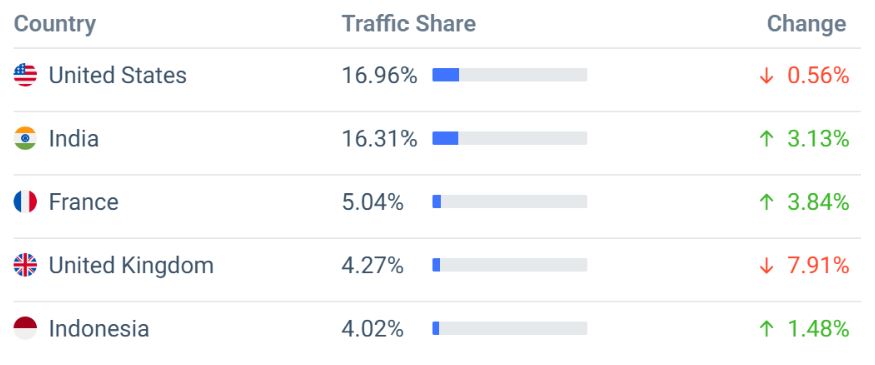
(Source: similarweb.com)
- Ahrefs and SEMrush have different niggardly traffic patterns and shifts in visitor interest across countries.
- For Ahrefs, the United States remains the largest contributor at 18.96%, although it has declined by 3.14%.
- India stood second with 16.37% of the traffic, but also recorded huge declines of 9.55%.
- The United Kingdom, contributing roughly 6.20% of traffic to Ahrefs, is also experiencing a 5.37% downfall.
- Pakistan, on the other hand, saw an increase of 1.50% in its share of traffic to 6.15%, and Mexico saw the most noteworthy ascent by rising 16.05% to account for 2.66% of the total traffic.
- But American users still give SEMrush their most considerable attention, which they pay in the first place, with just a small drop of 0.56%, meaning it is a little more stable.
- India, however, is nearly at par with the United States, generating 16.31% from SEMrush traffic with very positive growth of 3.13%.
- France saw healthy growth of 5.04%, but the UK dipped with a negative growth of 7.91% to 4.27%.
- Indonesia also saw a marginal increase of 1.48% up to 4.02% of SEMrush’s overall traffic.
- All in all, while both websites have the U.S. and India yielding the largest audiences, Ahrefs is looking at a trend of decline in these chief markets, whereas SEMrush seems to be either stable or experiencing growth in the same regions.
- While Ahrefs has popular traction in countries such as Pakistan and Mexico, SEMrush grows in France and Indonesia.
- These trends could, therefore, indicate separate regional marketing approaches or changing preferences for these tools among the international SEO communities.
Marketing Channels
Ahrefs

(Source: similarweb.com)
SEMrush

(Source: similarweb.com)
- Both Ahrefs and SEMrush are very reliant on direct traffic, with Ahrefs coming at 58.53% and SEMrush very slightly higher at 58.91%. This shows both brands enjoy very strong brand recognition and user loyalty, with the majority of visitors arriving directly by typing the URL or coming through bookmarks.
- However, when looking at organic traffic, Ahrefs definitely has a certain kind of edge with 37.69% of its users coming from search engines, as opposed to SEMrush with 30.79%, reflecting Ahrefs’ strength in SEO and organic visibility—which just makes sense for a company bearing the name and pitching itself as an SEO tool.
- On the other hand, SEMrush far outperforms Ahrefs in paid ads, accounting for 4.01% of its traffic through paid sources, compared to only 0.14% for Ahrefs, implying that SEMrush is much more active in acquiring traffic via paid search ads and other paid campaigns.
- With referral traffic in favour of SEMrush, we have a respective 3.92% of visits versus 2.48%, probably implying a larger pool of third-party websites linking to or recommending SEMrush.
- Display advertising is of little importance to either platform; however, SEMrush holds a tiny edge at 0.62% compared to Ahrefs’ mere 0.08%.
- Social traffic is also lower for both, but fares better for SEMrush at 1.67% over Ahrefs at 1.01%, perhaps hinting at a stronger, more active social media ecosystem.
- Email marketing, however, only brings in 0.06% for each platform, further reinforcing that this avenue is not a priority for either.
- While direct and organic remain biggies for both, SEMrush seems to have spread its stakes in acquisition channels more evenly, especially across paid- and referral-based sources.
Social Traffic
Ahrefs
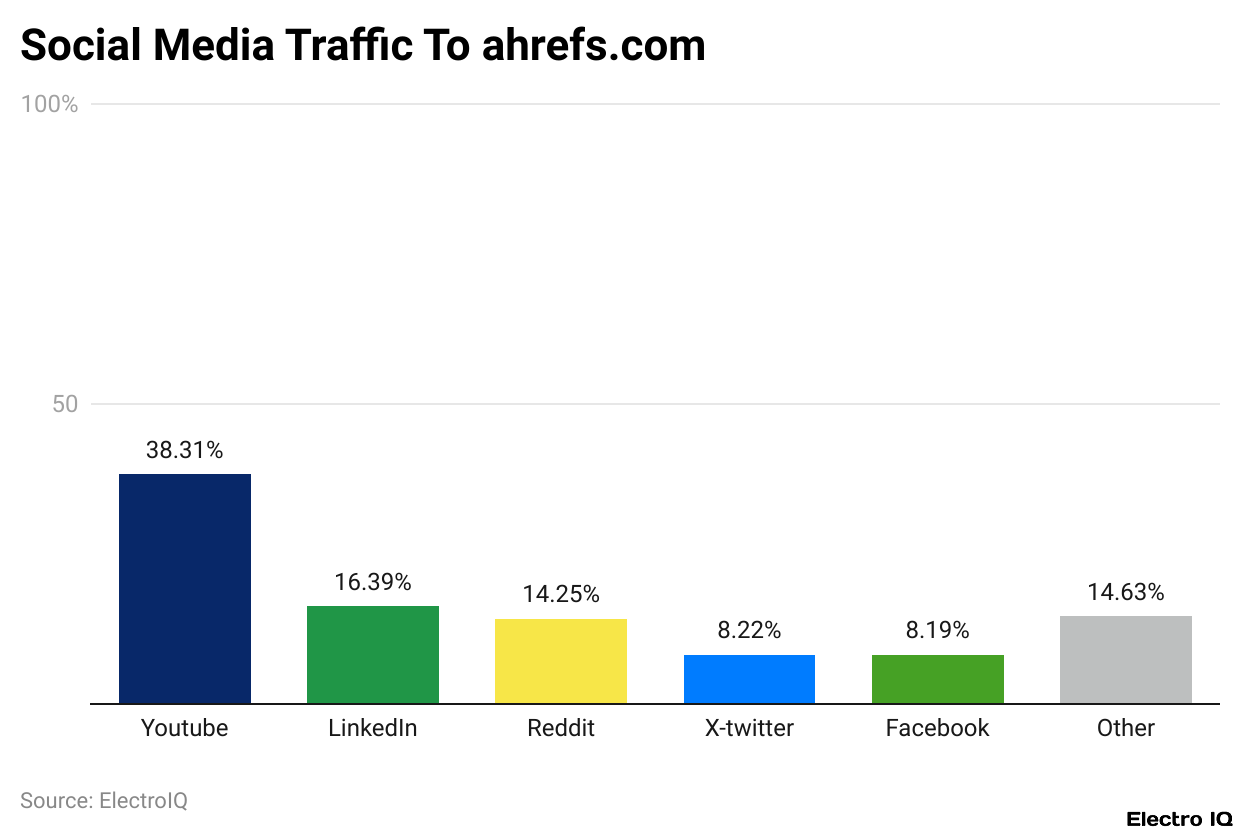
(Reference: similarweb.com)
SEMrush
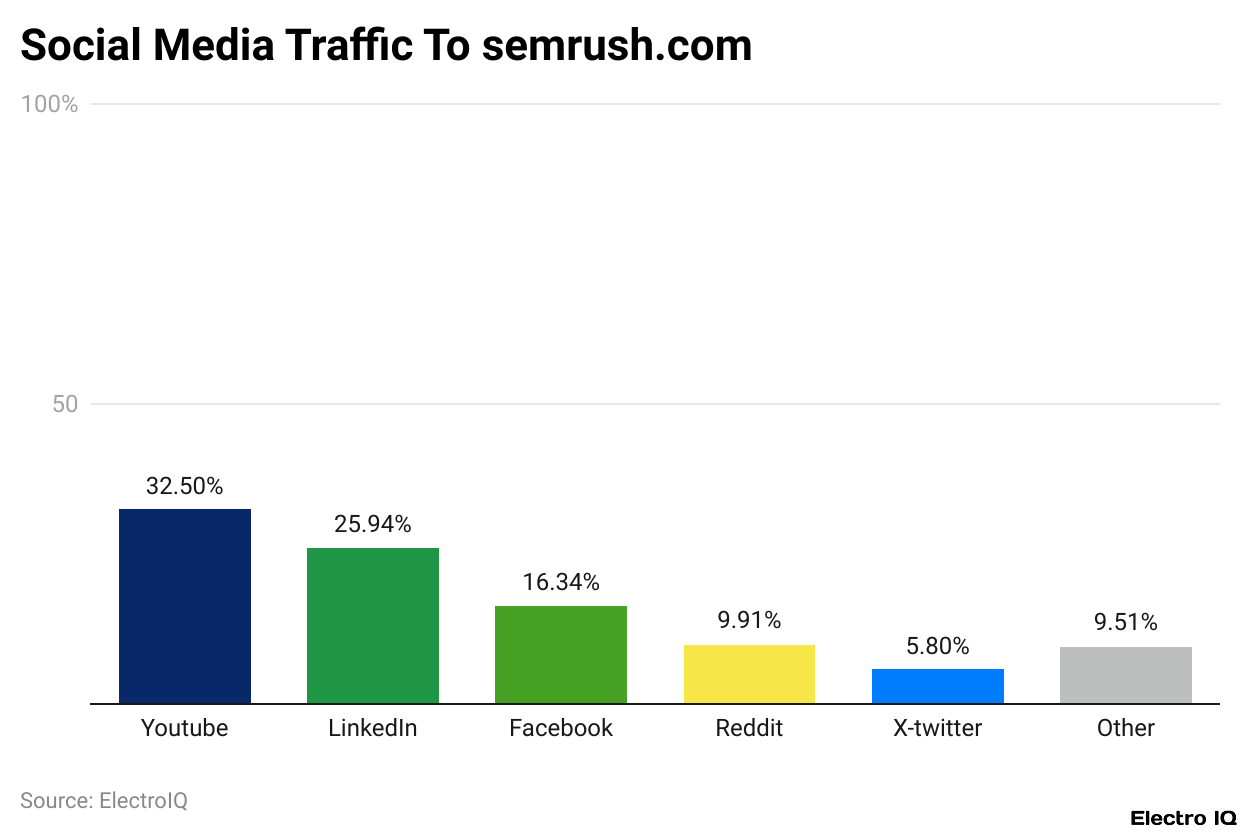
(Reference: similarweb.com)
- Both Ahrefs and SEMrush rely heavily on social platforms when it comes to driving traffic.
- However, the differences in the mix on these networks distinctly showcase disparities when it comes to audience engagement and platform strategy.
- YouTube accounts for 38.31% of all social traffic for Ahrefs, which heavily emphasises video content and tutorials to engage its users.
- Another way to see this is that SEMrush also considers YouTube as its greatest player for media and traffic, with a 32.50% mark, slightly less than Ahrefs’s share, which may indicate a slightly less pronounced concentration on video-based outreach.
- LinkedIn, however, plays a bigger role in SEMrush’s traffic generation, attracting 25.94% of the social traffic, compared to 16.39% for Ahrefs. This inverse indicates that SEMrush places a heavier emphasis on professional networking and B2B marketing.
- Reddit also throws in more for SEMrush at 16.34%, while Ahrefs pull a little less at 14.35%, benefiting community conversations, but with SEMrush having a slight edge.
- X (formerly Twitter) generates 9.91% of social traffic for SEMrush and 8.22% for Ahrefs, showing a similar level of involvement on this platform, while Facebook is a bigger source of social traffic subsidy for Ahrefs at 8.19% than at 5.80% by SEMrush, showing that Ahrefs might retain a bigger or general user base.
- Last but not least, SEMrush gets quieter from the “Other” side of 9.51% while Ahrefs turns loud at 14.63%, supporting the notion that Ahrefs enjoys a few more smaller or niche social platforms.
Website Demographics
Ahrefs

(Source: similarweb.com)
SEMrush

(Source: similarweb.com)
- The two platforms present somewhat analogous user demographics, but still vary significantly in terms of gender and age distribution. Ahrefs sees a more balanced gender split, with 58.7% of male users and 41.3% female users.
- SEMrush, on the contrary, enjoys the majority of a male audience, with 63.19% male and 36.81% female, perhaps signifying that its appeal might be slightly stronger on the male side in the digital marketing and SEO community.
- Viewing the age distribution, both platforms attract the biggest share of users in the 25–34 bracket, which constitutes 27.96% for Ahrefs and 29.09% for SEMrush, aligning with the age most common in taking on roles in digital marketing and SEO.
- In a distant second position for both is the 35–44 group, with Ahrefs showing great interest among professionals at 19.41%, only to be evaluated by SEMrush slightly higher at 20.74%.
- For 18- to 24-year-old users, Ahrefs tends to be more engaged, followed by SEMrush at 14.62%.
- The 45-54 age group is something of a close follow-up to that, with again SEMrush having a slight edge at 15.44% versus Ahrefs’ 14.90%.
- Interestingly, Ahrefs has 12.74% and 9.47% customers belonging to the older clientele of 55-64 and 65-plus, respectively, as against SEMrush being 12.22% and 7.90%.
- This might imply that Ahrefs holds a slightly broader appeal with upper age groups, while SEMrush generally maintains a younger-leaning user base.
Conclusion
Both Ahrefs and SEMrush promise stronger SEO and digital marketing toolsets, but with varying virtues. Ahrefs continues to be favoured for backlink searching and in-depth metric analysis, while SEMrush offers a more flexible toolset and larger quotas on reports.
Those wanting an inexpensive tool with all-around offerings would lean towards SEMrush, while those concerned about link quality and crawl frequencies should be interested in Ahrefs.
FAQ.
Ahrefs has experienced sharp year-over-year jumps in revenue, from US$1 million in 2011 to US$149.1 million in 2024. In comparison, SEMrush has enjoyed steady quarterly growth, surpassing US$105 million in Q1 2025. In other words, while Ahrefs shows the sharp spikes year over year, SEMrush’s quarterly reporting depicts consistent enterprise adoption and scaleability.
SEMrush’s Pro Plan, cheap enough for entry and users, starts at US$139.95/month, from where middle-tier plans are comparably priced at ~US$249/month. Large-scale requirements might face difficulty with Ahrefs’ Enterprise Plan at US$1,499/month as it’s way costlier than SEMrush’s top plan at US$499.95/month. Also, a paid Starter Plan for US$29/month and a free Webmaster Tool are offered.
Monthly data from May 2025 suggests that Ahrefs was consistently more heavily visited, along with weekly site visits that seemed more stable, hitting 2.285 million visits in the first week of the month and staying in the vicinity of 2.27 million for subsequent weeks. In contrast to that stability, SEMrush’s site traffic was more volatile, with an evident downward trend from the middle of May, thereby allowing us to infer that, in user engagement, Ahrefs has held the stronger and more consistent presence.
They both draw heavily on direct traffic, with percentages shown at 58.53% and 58.91% for Ahrefs and SEMrush, respectively. Yet, Ahrefs rules in organic search traffic, 37.69% to just 30.79% in favour of SEMrush, which affords further recognition for its SEO strength. SEMrush is eligible slightly ahead in paid search advertising (4.01% to 0.14%) and referrals (3.92% to 2.48%), showing yet another Avangere-style acquisition strategy. Further, SEMrush rules the social media presence and engagements, mainly through LinkedIn and Reddit.
Ahrefs is more balanced between the genders (58.7% male and 41.3% female), while SEMrush leans even more male (63.19%). Both platforms share an identical largest age segment: 25–34. The demographics are a little older for Ahrefs, having been weighted more heavily toward the 55–64 and 65+ age brackets, which speaks of a more generational appeal compared to the younger-leaning audience of SEMrush.

Maitrayee Dey has a background in Electrical Engineering and has worked in various technical roles before transitioning to writing. Specializing in technology and Artificial Intelligence, she has served as an Academic Research Analyst and Freelance Writer, particularly focusing on education and healthcare in Australia. Maitrayee's lifelong passions for writing and painting led her to pursue a full-time writing career. She is also the creator of a cooking YouTube channel, where she shares her culinary adventures. At Smartphone Thoughts, Maitrayee brings her expertise in technology to provide in-depth smartphone reviews and app-related statistics, making complex topics easy to understand for all readers.






